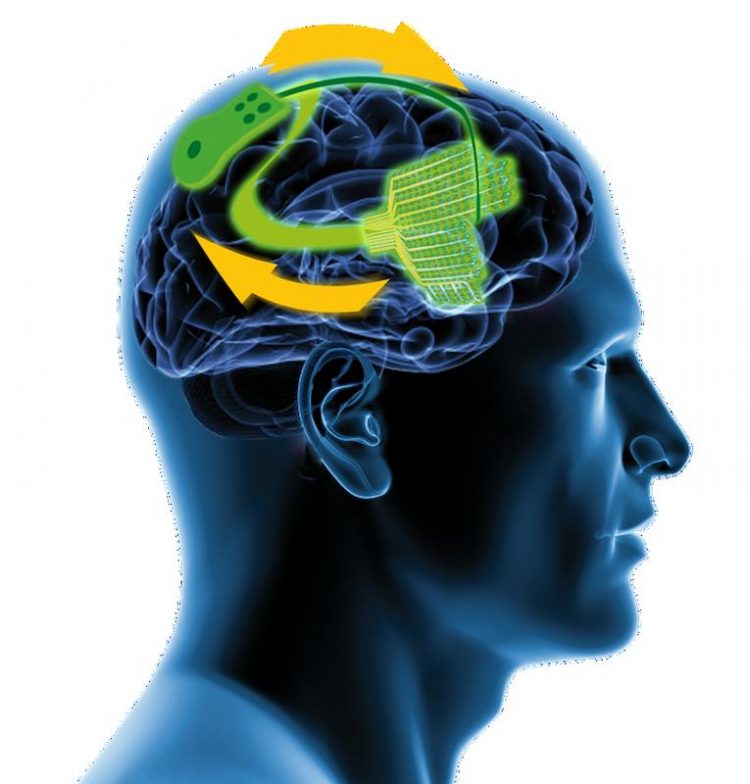The Molecular Breakdance of Seeing

Artist's impression of the molecular motion in the retina. J.M. Harms, MPSD
The detection of light by pigments in the retina, called rhodopsin or visual purple, leads to our sense of vision. New experiments by scientists from the Max Planck Institute for the Structure and Dynamics of Matter and the University of Toronto have revealed that the primary photochemical event of this process operates at the fundamental molecular speed limit. These results are reported online in the journal Nature Chemistry today.
The retinal chromophore in rhodopsin, also called vitamin A aldehyde, derives its light sensitivity from a repeating chain of single- and double-bonded carbon atoms. The absorption of a photon by retinal causes an extremely short transient weakening of a specific double bond resulting in rotation about that bond.
Pinpointing how fast this so-called chemical isomerization reaction occurs has been difficult, however, and has largely tracked the technological advances in pulsed laser sources. With femtosecond lasers it was shown that the isomerization takes place within 200 femtoseconds (that is 200 millionths of a billionth of a second), and is likely a vibrationally-coherent chemical reaction, meaning the vibrational motions of the retinal chromophore itself help directing the isomerization reaction.
Using a highly sensitive technique from the field of ultrafast spectroscopy called heterodyne-detected transient grating spectroscopy, scientists in the laboratories of Professors R. J. Dwayne Miller (University of Toronto and Max Planck Institute for the Structure and Dynamics of Matter) and Oliver P. Ernst (University of Toronto) revisited the isomerization reaction of bovine rhodopsin with unprecedented sensitivity and temporal resolution.
Such an approach revealed that the isomerization takes place on a timescale of 30 femtoseconds. “It turns out that the primary step of vision is nearly ten times faster than anyone thought,” says Professor Miller, “and the atomic motions are all perfectly choreographed by the protein.”
Temporal analysis of the experimental data revealed these choreographed vibrational dynamics, which are comprised of localized stretching, out-of-plane wagging, and torsional motions. “Such a fast timescale sets distinct limitations on the vibrationally-coherent reaction coordinate,” says Dr. Philip Johnson, lead author of the study, “and this work indicates that it is local to the specific isomerizing double bond.”
“Moreover,” he adds, “the isomerization reaction proceeds within a single period of the relevant torsional vibrational motion. The notion of fully vibrationally-coherent chemical reactions has been around since at least the 1930s, but really hasn't been explicitly observed until now.”
This research was supported by the Max Planck Society, the Natural Sciences and Engineering Research Council of Canada (NSERC), the Canada Excellence Research Chairs program (CERC), and the Canadian Institute for Advanced Research (CIFAR). Professor Miller and Professor Ernst are co-directors of CIFAR’s program Molecular Architecture of Life, which is untangling the details of the complex molecular processes that underlie all living systems.
Contact person:
Prof. Dr. R. J. Dwayne Miller
Max Planck Institute for the Structure and Dynamics of Matter
Center for Free-Electron Laser Science
Luruper Chaussee 149
22761 Hamburg
Germany
+49 (0)40 8998-6200
dwayne.miller@mpsd.mpg.de
Original publication:
Philip J. M. Johnson, Alexei Halpin, Takefumi Morizumi, Valentyn I. Prokhorenko, Oliver P. Ernst, and R. J. Dwayne Miller, “Local vibrational coherences drive the primary photochemistry of vision,” Nature Chemistry 7, 980–986 (2015), DOI: 10.1038/nchem.2398
http://dx.doi.org/10.1038/nchem.2398 Original publication
http://www.mpsd.mpg.de/mpsd/research/ard Research group of Prof. Dr. R. J. Dwayne Miller
http://www.mpsd.mpg.de/en Max Planck Institute for the Structure and Dynamics of Matter
Media Contact
All latest news from the category: Life Sciences and Chemistry
Articles and reports from the Life Sciences and chemistry area deal with applied and basic research into modern biology, chemistry and human medicine.
Valuable information can be found on a range of life sciences fields including bacteriology, biochemistry, bionics, bioinformatics, biophysics, biotechnology, genetics, geobotany, human biology, marine biology, microbiology, molecular biology, cellular biology, zoology, bioinorganic chemistry, microchemistry and environmental chemistry.
Newest articles

Bringing bio-inspired robots to life
Nebraska researcher Eric Markvicka gets NSF CAREER Award to pursue manufacture of novel materials for soft robotics and stretchable electronics. Engineers are increasingly eager to develop robots that mimic the…

Bella moths use poison to attract mates
Scientists are closer to finding out how. Pyrrolizidine alkaloids are as bitter and toxic as they are hard to pronounce. They’re produced by several different types of plants and are…

AI tool creates ‘synthetic’ images of cells
…for enhanced microscopy analysis. Observing individual cells through microscopes can reveal a range of important cell biological phenomena that frequently play a role in human diseases, but the process of…





















